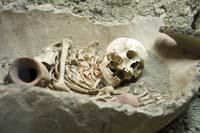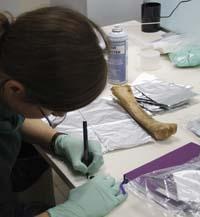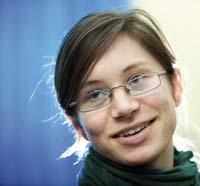Carbon 14 of high quality
01/11/2010 | Roa Zubia, Guillermo | Elhuyar Zientzia Komunikazioa

Neanderthal remains in a tomb at the Archaeological Museum of Antalya, Turkey. Ed. : © iStockphoto.com/R.V. Bulck.
There are two ways to analyze the radiocarbon of a fossil, that is, the amount of the carbon isotope 14, that is, an accelerator/mass spectrometer or calculate the amount of radiation emitted by the sample can be used. "We've used this for many years, it's a very good method if you have large samples," says lab expert Rachel Wood RLAHA. "But through the accelerator, much smaller samples can be analyzed, as occurs in archaeology."
The amount of carbon 14 in a fossil bone indicates the age of the bone, as it loses the carbon 14 it had at first over time. A carbon neutron becomes a proton and the isotope becomes 14 nitrogen. The speed of this process is known, so knowing the amount of carbon 14 of a fossil can be calculated the year to which it belongs. In theory it is easy.
But, in fact, dating the bone is very difficult for archaeologists, since it was originally a component of bone, carbon, it must be extracted. In addition to the original, it contains the carbon that has absorbed from the environment for years. The natural carbon of the bone is a very small quantity; it is the carbon of the original proteins, collagen in 90%. "We dissolve the bone in a process in which proteins pass into dissolution. In this solution we try to isolate the fibers that contain collagen and discard everything else."
However, it is a delicate work. For this reason, about ten years ago, the experts of the RLAHA laboratory were concerned about the pretreatment of entry to the accelerator. On the one hand, the original carbon loss of the bone, and on the other, the contamination with external carbon, two effects that forced to question the accuracy of the dating. With the aim of improving the method, in 1988 a Canadian group found a proposed technique: to use an ultrafiltration to eliminate external pollution. It was common in biochemistry but not in archaeology. The Canadian team did not use this technique much either. But the Oxford retook the idea and improved the technique.
At present, the RLAHA laboratory team uses ultrafilters of polyetersulfone to capture small aggregates of collagen fibers. The sample is centrifuged to pass the ultrafiltration, each collagen fiber is a molecule of about 100 kilodalton, that is, a small protein, and the polyetersulphone polymer network captures groups greater than 30 molecules. The carbon 14 of these proteins captured for dating is analyzed below.
Fine technique, unforeseen results
This process greatly alters the accuracy of the dating. "The difference between the result of this technique and that of the conventional technique can be of 20,000 years. That is the maximum we have achieved. Analyzing a sample of 32,000 years old using conventional methods with the carbon technique of collagen, gave me a result of 50,000 years." Sometimes there is usually not so much difference; when the bone is not contaminated, the traditional method works very well. However, in cases of contamination, analysis of the 14 carbon of collagen differs greatly.

Rachel Wood in San Sebastian, working with the remains of the Labeko Cave. Ed. : Aritza Villaluenga.
With the collagen methodology, the precision of the radiocarbon technique is very high in the medieval samples, with an error of 15-20 years, while in the samples of 30,000 years the error is 500-1,000 years. "The problem is that we need a temporary calibration because throughout history the amount of CO 2 of the atmosphere fluctuates. This factor defines the datation error."
Oxford's RLAHA laboratory is not the only one that isolates and analyzes the carbon of collagen. Many laboratories extract collagen from fossil bones. And there are many chemical methods to do so. In the laboratory of Gif-sur-Yvett (France), for example, they eliminate carboxylate to proteins by treating with the ninhydrine molecule and work in the gaseous phase. Otherwise, in most laboratories work as in RLAHA but without filtering the sample. However, the ultrafiltration method is the most accurate of the moment. "Little by little they have begun to be ultra-fast in many laboratories and within about five years it will be usual," Wood believes.
Rachel Wood: "It is nice to be in the center of all departments, it is a combination of archaeological sciences"
Researcher of 26 years, chemist of the laboratory RLAHA of Oxford and specialist in paleontology and archaeology. The Neanderthal Man is the main object of research, in which he collaborates with numerous groups of European archaeologists. Among them are the archaeologists of the UPV/EHU, due to the abundance of archaeological treasures of the time studied by Rachel Wood in the deposits of the Basque Country.
You live in the city of Oxford, but you are not English.
I was born in South Africa, but I came to England at age four. There, in South Africa, I still have relatives, but at the base I am English.
Have you always lived in Oxford?
No. I have moved a lot from one place to another. At first I lived in Luton, then in Portsmouth, and did the race in Durham. Oxford has been his last residence.
At Cambridge there is also a scientist named Rachel Wood.
Yes, a geologist. Rachel Wood is a very common name in England.
You are a chemist. How did you come to work with archaeologists?
I have always been interested in history, also in school. So I learned a little archeology to see how it really is. But I also like chemistry, and in the career I studied chemistry. Then I did some masters of archaeology. Archaeology uses a lot of chemistry, geology, and other sciences. It is a combination of sciences.
In universities, the departments of archaeology and paleontology are located in the faculties of art and history.
Yes, but our department was close to physicists and chemists. We have had a lot to do with them. There are many students who have completed a doctorate in these areas and then return to us. However, we cannot say that we are physical and chemical, we do not know what physical meaning some samples have and what questions to answer. Somehow, the archaeological work is more practical. It is nice to be in the center of all departments (laughter).
You work on the limit of the radiocarbon dating technique. Why?

(Photo: Jon Urbe/Argazki Press)
Because it is interesting. Because it is difficult. The medieval dating is simple with the carbon-14 technique. But if you go back in time, pollution problems appear, since there are very few carbon-14 in the samples.
Hence the importance of the chemical pretreatment of the samples. You must remove all contaminants as they have great influence on dating. Considering that I have studied chemistry, this part is the most interesting.
The main interest of his work is in the Iberian peninsula. Why?
Our laboratories have worked a lot in England. So with my project we wanted to extend it to Europe. They wanted to study the subject of the duration of Neanderthals in Western Europe and I was very interested.
Have you found many competitors in other states?
Not precisely because I come from the radiocarbon laboratory. We did not compete with archaeologists. We help them answer questions they can't answer. We could also compete with other radiocarbon laboratories, but that doesn't happen either. Our works are complementary. And, in general, the work of a laboratory serves to contrast with the result of another and to obtain a coherent result between both works.
How many laboratories are you in Europe approximately?
In each locality there is one or two laboratories. The maximum number of people working is about ten, the radiocarbon is a relatively small space. The apparatus we use, an AMS mass spectrometer (Accelerator Mass Spectrometer) is extremely expensive, it is a national resource that can only have a country.
Is the situation in the United States similar?
In the United States there are laboratories. But they are not specialized in archaeology, but in the investigation of physical geography (glacial processes, marine systems, etc. ), especially because there are not as many archaeological sites as in Europe.
What work do you do with UPV archaeologists?
The samples of my thesis and the main research that I will have in my possession are those taken in the European West: Germany, France, Portugal and Spain. I want to know when the last Neanderthales disappeared and when the first modern men arrived. We analyze especially the industries of these human beings, as those exposed in the Cave of Labeko. And in cases like the Cave of Labeko we work with archaeologists of the UPV. That is why I have come here.
Puente Roa, Guillermo
Services Services Services
269 269 269
2010 2010 2010 2010 2010 2010
Results Results Results
022 022
Paleontology
Article Article Article
Security security security security














